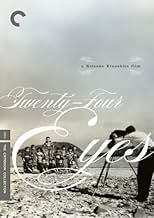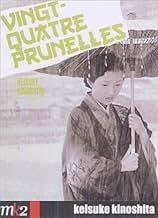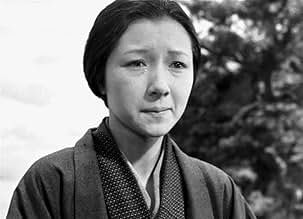IMDb रेटिंग
8.0/10
3.1 हज़ार
आपकी रेटिंग
अपनी भाषा में प्लॉट जोड़ेंSchoolteacher Hisako Oishi forms an emotional bond with her pupils and teaches them various virtues, while at the same time worrying about their future.Schoolteacher Hisako Oishi forms an emotional bond with her pupils and teaches them various virtues, while at the same time worrying about their future.Schoolteacher Hisako Oishi forms an emotional bond with her pupils and teaches them various virtues, while at the same time worrying about their future.
- निर्देशक
- लेखक
- स्टार
- पुरस्कार
- 10 जीत और कुल 1 नामांकन
फ़ीचर्ड समीक्षाएं
It was a pleasure for me to see this lovely movie, a film I've really wished to see in the last four years but I couldn't do it until today. I heard about this movie when I lived in Japan and visited Shodoshima island, where "Eiga Mura" (Cinema Village), the place this film was made, can still be visited and the atmosphere of the past can be enjoyed. To be honest, I must say that "Nijushi no hitomi" wasn't for me the "exceptional film" I expected to see, but anyway it has been a pleasant experience. The life of the rural teacher, from the start of her career (in the mid 20's) to the time she retakes her teaching position after having become a widow (in the 40's, after the end of WWII), is an interesting guide to discover the traditional life and mentalities in the small islands of Seto (Japan Inland Sea). A good point for this film: it is usually said that this is an "anti-war" film. Well, it is true that the teacher shows a clear position against the wars Japan was involved (the war against China and the later Pacific War against the USA), but this film mustn't be considered as a pacifist pamphlet: the honest position of the teacher against the war is just one more detail in this complete description of how life should be in rural Japan during those difficult prewar, war and postwar years. A film that should be shown in every school around the world.
Compared to a film like "Pigs And Battleships", or even "I Live In Fear"; Kinoshita's film is a middlebrow, mainstream, even sentimental take on the Japan's war years and it's aftermath.
Still, the film is graceful and touching, with what Pauline Kael called "concealed art." Kinoshita's approach seems to be to take potently maudlin situations, and film them from an objective distance; with as direct and simple emotion as possible.
This may short change the great Takamine a bit; we seem to be an hour into the film before the great actress receives a close up. Still, her performaces gains power as the film goes on.
Though politics are kept in the background, as perhaps they had to in a Japanese film of this nature; but there is an anger lurking in the backgroud; an inditement of a culture that would waste the strength of it's woman and worse; reduce it's men to cannon fodder. Was it something in Japanese life; rather than just it's military, that led to it's disasters? Even the country's great filmmakers seem hesitant to speculate. In any event, another strong film of interest to all those who have fallen under the spell of great Japanese film.
Still, the film is graceful and touching, with what Pauline Kael called "concealed art." Kinoshita's approach seems to be to take potently maudlin situations, and film them from an objective distance; with as direct and simple emotion as possible.
This may short change the great Takamine a bit; we seem to be an hour into the film before the great actress receives a close up. Still, her performaces gains power as the film goes on.
Though politics are kept in the background, as perhaps they had to in a Japanese film of this nature; but there is an anger lurking in the backgroud; an inditement of a culture that would waste the strength of it's woman and worse; reduce it's men to cannon fodder. Was it something in Japanese life; rather than just it's military, that led to it's disasters? Even the country's great filmmakers seem hesitant to speculate. In any event, another strong film of interest to all those who have fallen under the spell of great Japanese film.
People who view this film would do well to consider the sentiment of post-war Japan in the mid-50s, when the future was still uncertain and the vast devastation and shame caused by the war were prevalent in the mindset of its citizens.
The timing for this film's release was significant, because perhaps for the first time, it permitted the people of Japan to cry unabashedly for themselves, far removed from any political statement so frequent in Shochiku films such as with many of Kurosawa's classics. Movies at the time tended to have positive, uplifting themes that motivated the populous to help rebuild the country into a modern democratic nation. You can thank Douglas MacArthur for that.
The post-war generation was now almost 10 years old, and in the Japanese psyche was the need for justification for its darkest period in history.
This film served as a reminder of the horrors of war, not from the battlefields, but from the emotional scars left on its children who lived and died during it.
Hideko Takamine brilliantly played the role of a school teacher on a typical remote island community in south Japan during an increasingly militarist government. As was customary at the time, the same teacher saw to their students' education from primary to high school, forming a lifetime bond.
Director Keisuke Kinoshita's camera work is nothing less than genius, beautifully portraying the transitions of seasons from year to year. The water, sand, and dust textures are so distinct that you almost forget that it was filmed in black and white.
The character closeups are never exaggerated and the 12 children actors (hence "24 Eyes") do an outstanding job portraying how they end up sacrificing their childhood dreams due to poverty and for national duty.
Of symbolic note is the appearance of the Island bus, which is seen at first with Japanese kanji characters painted on the side. Later in the film, it's written in English as "Shima Bus", signifying how modernization has reached the island after the war.
From cast, location and cinematography, Nijushi no Hitomi is a masterpiece of emotional storytelling.
The timing for this film's release was significant, because perhaps for the first time, it permitted the people of Japan to cry unabashedly for themselves, far removed from any political statement so frequent in Shochiku films such as with many of Kurosawa's classics. Movies at the time tended to have positive, uplifting themes that motivated the populous to help rebuild the country into a modern democratic nation. You can thank Douglas MacArthur for that.
The post-war generation was now almost 10 years old, and in the Japanese psyche was the need for justification for its darkest period in history.
This film served as a reminder of the horrors of war, not from the battlefields, but from the emotional scars left on its children who lived and died during it.
Hideko Takamine brilliantly played the role of a school teacher on a typical remote island community in south Japan during an increasingly militarist government. As was customary at the time, the same teacher saw to their students' education from primary to high school, forming a lifetime bond.
Director Keisuke Kinoshita's camera work is nothing less than genius, beautifully portraying the transitions of seasons from year to year. The water, sand, and dust textures are so distinct that you almost forget that it was filmed in black and white.
The character closeups are never exaggerated and the 12 children actors (hence "24 Eyes") do an outstanding job portraying how they end up sacrificing their childhood dreams due to poverty and for national duty.
Of symbolic note is the appearance of the Island bus, which is seen at first with Japanese kanji characters painted on the side. Later in the film, it's written in English as "Shima Bus", signifying how modernization has reached the island after the war.
From cast, location and cinematography, Nijushi no Hitomi is a masterpiece of emotional storytelling.
Nearly everyone who rated this film gave it 10/10, and it's easy to see why. This is a wonderful and bittersweet story about a teacher and her first twelve students, the "24 eyes" of the title, on a fairly remote island community. The story sweeps over about 20 years, from the students in the first grade, then the sixth, then as later teenagers, then four years later. The story begins in the late 1920s, and thus spans a turbulent time in Japanese history, which of course impacts greatly on the characters, even on a fairly isolated island.
Hideko Takamine is perhaps my favourite Japanese actress. This luminous and loveable women with the dazzling smile is a joy to behold and, playing the object of much affection from the children (though only sometimes from the adults), creates a wonderful feeling. Man, I wish I'd had her as a teacher in lower primary school.
There's a strong sense of community in this story, which is one of its strong points, but it is not always a positive thing for the characters. The older women gossip, of course, about the 'modern' new teacher, because she rides a bike and wears western clothes.
The director expertly presses all the emotional buttons of the audience. There are some people who detest this sort of thing, but I'm a sucker for it. In the hands of an expert director, and for the purposes of entertainment, there's nothing wrong with being taken on a emotional roller-coaster ride. There are some high points and many sad events in the story, which moves along at a pace which is sometimes leisurely but never dull.
This film is not free of faults. Aside from the very overt emotional manipulation, there are several tunes which are vastly overused. For instance, "auld lang syne" is played at least ten times.
Also, and most surprisingly, Hideko's range is limited. Despite two and a half hours, together with Hideko being the undisputed star, she shows only three expressions during the entire proceedings. Comparison to the superb HAPPINESS FOR US ALONE shows this clearly. In HFUA, Hideko plays a deaf-mute and uses her wonderfully expressive face to full effect.
But these are minor points, and no reason to mark it down from a perfect score. This is a must-see for anyone who loves film.
Hideko Takamine is perhaps my favourite Japanese actress. This luminous and loveable women with the dazzling smile is a joy to behold and, playing the object of much affection from the children (though only sometimes from the adults), creates a wonderful feeling. Man, I wish I'd had her as a teacher in lower primary school.
There's a strong sense of community in this story, which is one of its strong points, but it is not always a positive thing for the characters. The older women gossip, of course, about the 'modern' new teacher, because she rides a bike and wears western clothes.
The director expertly presses all the emotional buttons of the audience. There are some people who detest this sort of thing, but I'm a sucker for it. In the hands of an expert director, and for the purposes of entertainment, there's nothing wrong with being taken on a emotional roller-coaster ride. There are some high points and many sad events in the story, which moves along at a pace which is sometimes leisurely but never dull.
This film is not free of faults. Aside from the very overt emotional manipulation, there are several tunes which are vastly overused. For instance, "auld lang syne" is played at least ten times.
Also, and most surprisingly, Hideko's range is limited. Despite two and a half hours, together with Hideko being the undisputed star, she shows only three expressions during the entire proceedings. Comparison to the superb HAPPINESS FOR US ALONE shows this clearly. In HFUA, Hideko plays a deaf-mute and uses her wonderfully expressive face to full effect.
But these are minor points, and no reason to mark it down from a perfect score. This is a must-see for anyone who loves film.
25 years ago I made up my mind I would move to Japan. So I wrote to people in Japan who had lived there for over thirty years, and asked them what would be the #1 movie I should watch that encapsulated the spirit of the Japanese.
They all suggested "24 Eyes".
Now, after having lived in a strictly Japanese environment for five years, and having seen well over thirty Japanese movies, not to mention over a thousand hours of TV shows and animae, it is still the #1 to me.
By today's standards it will seem extremely "G" rated, a little too slow and a bit too long. But for those who want to really understand people, and where they are coming from, I can't think of a better movie to recommend. I wish every culture, particularly those that may be going extinct, would use this movie as a guideline to tell their story.
They all suggested "24 Eyes".
Now, after having lived in a strictly Japanese environment for five years, and having seen well over thirty Japanese movies, not to mention over a thousand hours of TV shows and animae, it is still the #1 to me.
By today's standards it will seem extremely "G" rated, a little too slow and a bit too long. But for those who want to really understand people, and where they are coming from, I can't think of a better movie to recommend. I wish every culture, particularly those that may be going extinct, would use this movie as a guideline to tell their story.
क्या आपको पता है
- ट्रिवियाAccording to Japanese film critic and historian Tadao Satô, in casting this film about a schoolteacher and her relationships with her pupils over many years, director Keisuke Kinoshita very cleverly chose pairs of look-alike siblings to portray the students. So for those scenes set in later years, Kinoshita simply substituted the older siblings for the younger ones, so that the schoolchildren appeared to "grow" before the audience's eyes.
- कनेक्शनReferenced in Hakuchû no tôrima (1966)
- साउंडट्रैकAnnie Laurie
टॉप पसंद
रेटिंग देने के लिए साइन-इन करें और वैयक्तिकृत सुझावों के लिए वॉचलिस्ट करें
- How long is Twenty-Four Eyes?Alexa द्वारा संचालित
विवरण
- चलने की अवधि2 घंटे 36 मिनट
- रंग
- ध्वनि मिश्रण
- पक्ष अनुपात
- 1.37 : 1
इस पेज में योगदान दें
किसी बदलाव का सुझाव दें या अनुपलब्ध कॉन्टेंट जोड़ें











